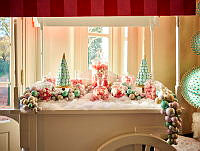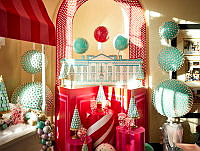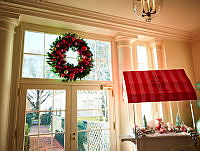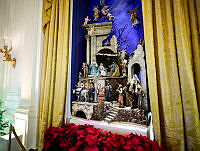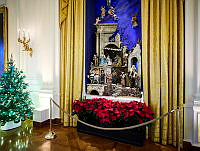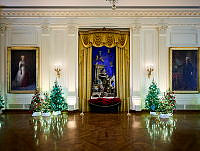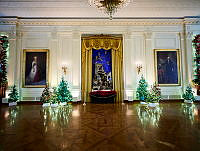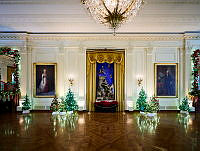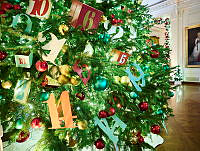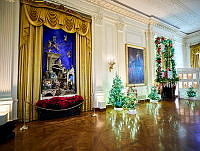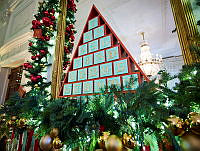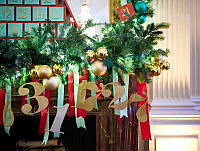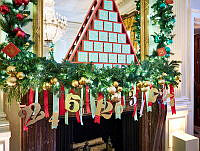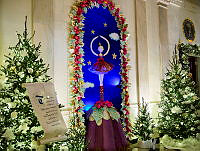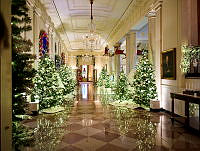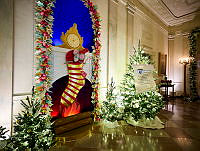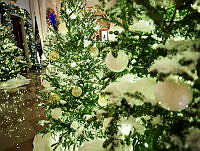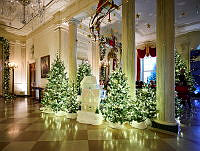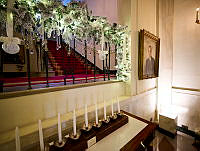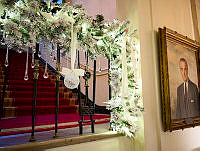An Artist Visits the White House Past
Paintings by Peter Waddell
Copyright © White House Historical Association. All rights reserved under international copyright conventions. No part of this article may be reproduced or utilized in any form or by any means, electronic or mechanical, including photocopying, recording, or by any information storage and retrieval system, without permission in writing from the publisher. Requests for reprint permissions should be addressed to books@whha.org

Peter Waddell, Lafayette Square, oil on canvas, 48 x 60 inches.
Peter Waddell for the White House Historical AssociationThe fourteen paintings in this series were commissioned from Peter Waddell beginning in 2004 by the White House Historical Association. It was the associations wish that the artist create well-researched pictures representing different periods from the White House past that were not drawn, painted, or photographed definitively in their own times. Rather than attempting to capture great events, Waddell decided to take odd moments in presidential life at the White House. Thus you will see Dolley Madison entertaining in her drawing room; the second President Adams taking a dangerous swim; a social workers visit with a relaxed Abraham Lincoln in his office; a great cheese placed in the center of Andrew Jacksons East Room; Theodore Roosevelts son and pets in the now-vanished conservatory, and other interludes, not least one bright and lively representation of the Entrance Hall showing the Tiffany glass screen, gone now for over a hundred years.
Re-creating the past is nothing new to art, and representing domestic scenes was well known in the seventeenth and eighteenth centuries. As with movies yet to come, the scenes themselves were usually secondary to the people portrayed in them. Peter Waddell's White House pictures relate more to nineteenth-century traditions, when houses and interiors were painted for their own sake. Private living quarters, notably in the palaces of Eastern Europe—Austria for example—were often preserved in oil or watercolor, for all but the basic furnishings were in place for only a season at court and removed elsewhere when that was over.
The conscious attempt to illustrate historic interiors as interiors, with costumed figures in them was a different matter entirely and saw its first significant early expression in The Mansions of England in the Olden Time, a large folio published in 1840 by the lithographer Joseph Nash. An antiquarian and genre artist, Nash challenged the eighteenth-century idea that early houses in England had been cold and uncomfortable. His plates celebrated their human and picturesque qualities. The galleries, bedchambers and halls of England's most notable historic houses were rendered by Nash in detail, as they might have been in the times of the Tudors and Stuarts. To his old houses he added costumed characters, anonymous, most of them, in the course of everyday life.

Peter Waddell, The Grand Illumination, oil on canvas, 55 x 73 inches.
Peter Waddell for the White House Historical AssociationHow Nash's scenes differed from most others was that his represented the antithesis of the decorated room setting that was well established by 1840. The concept of creating interiors as ensembles of unified design had come into its own in the early nineteenth century, and for many years inspired a whole genre of paintings for the market of fashion it represented. Decorated rooms boasted the owners good taste, although that was subject to judgment. Use of the medium of paint and canvas for house illustrations died out when photography took over. In Nash's lithographed rooms the architecture and characters were the main features, furniture and other objects being secondary and always sparse.
Peter Waddell's White House paintings represent a combination of both approaches. They are antiquarian, to be sure, in their scholarship. The architecture is rendered as it exists or, in some cases restored to the way some vanished or altered piece is known to have looked. Accurate details of furniture and costume are brought in not for style, but to enrich the representation of human use, for it is the human side of presidents that interests us most in visiting the White House. The scenes are believable, and in painting them Waddell has wished to entertain as well as inform.
The late Professor Mario Praz, scholar of interiors, liked the concept about interiors by the German philosopher Walter Benjamin: "The interior represents the universe for the private individual. He collects there whatever is distant, whatever is of the past. His living room is a box in the theater of the world." One pauses over this when considering the White House, where the occupants make their box seat but own neither it nor what is contained in it.
They live with what they may have acquired with public funds or what they borrow from the presidential past. They gather the chairs and tables, the portraits and tableware of their predecessors into settings for themselves during their own short tenures. A storage warehouse kept off-site is available to help with any readjustments, its contents being former White House furnishings, which by law must be retained. Every object that is returned to service carries a history of its own and has acquired another layer by the time it returns to the warehouse.
The [White House] stands, rebuilt, remodeled, strengthened, and vigilantly maintained yet still clearly recognizable as the structure George Washington approved more than 200 years ago.
In a sense the White House is an unusual sort of family home, with a big attic. The building stands, rebuilt, remodeled, strengthened, and vigilantly maintained yet still clearly recognizable as the structure George Washington approved more than 200 years ago. Presidents come and go, arranging things as they see fit, within the context largely of what is there. The White House welcomes the new presidents with formats and procedures already well-honed over time to serve him well.
Peter Waddell's decision to venture into the past committed him to much more than pursuit of his skill with paint, brushes, and canvas. To find details he read extensively the history surrounding the fourteen episodes in his pictures. In the National Archives, record group 42, thousands upon thousands of pages carry one back two centuries through the intimate life of the White House and its presidents, the furniture they used, the dishes they ate upon, the services for which they had to summon tradesmen, whose faded invoices are revealing.
He studied inventories of the house, and they exist for every administration. As any government official knows, scandal-seekers fix more readily upon spending public funds for a $750 office table, which can be quickly envisioned, than a $30,000,000 highway, which is not only cumbersome to describe but rather an abstraction. At the White House great care has always been taken to keep an updated record of the government-owned contents of the building, which may vary from a gilded mirror to a kitchen pot, all potential symbols of official extravagance. When Waddell shows, for example, Andrew Jackson's East Room, he may have no precise documentation for how the Great Cheese consumed there looked, but he has pretty solid information on everything else, even the papier-mache stars and rays over the door that crowned Old Hickory's dramatic entrances.
Maps, letters, memoirs, and published accounts are central to any research on the White House. John Quincy Adams, in his diary written that night, literally set down guidelines for Waddell's depiction of the presidents near-drowning. In his search for information, the artist consulted the visual materials. For example, for the Roosevelt conservatory he used thick files of photographs in the Prints and Photographs Division of the Library of Congress showing the long-vanished buildings; but the photographs were supplemented with the gardeners listings of tropical plants that grew beneath the glass ceilings, and the plants form the major feature of the picture.

Peter Waddell, Tiber Creek: The Bathers, oil on canvas, 48 x 72 inches.
Peter Waddell for the White House Historical AssociationAttempting total recall of the past is risky, no matter the medium. The easiest way to re-create the past is with the written word, for with the right words one can build mental images from sparse materials—the tall, brown autumn grass in the meadow (when you know tall brown grass was certainly present at a given place in November), or an orderly row of gilded chairs (when you know the ballroom had gilded chairs, almost certainly set in lines, given their great number).
A historical painting, however, requires more than a draftsman's ability to replicate what he finds in research. The painter is imposing his imagination upon that of the viewer. This requires skill as an artist to reach a believable, comprehensive image with which a viewer is willing to replace his own mental image of how it was. A painter achieves this in the status he gives to forms on the canvas, his interpretation of documented color alongside created color, but most of all, in the way he wakens our emotions with his use of light. Peter Waddell's White House pictures are thus his, as much as they are factual images gleaned from the documentation he has brought to them.
Best known for his paintings of Washington, D.C., history and architecture, Peter Waddell began his career in New Zealand where he was born in 1955. He attended the School of Fine Arts at Canterbury University and after considerable success in New Zealand as an artist, he came to Washington, D.C., in 1994 and became a United States citizen in 2002. In addition to the White House, Peter's subjects have included the Capitol, the Octagon, Mount Vernon, and other historical sites. Recent smaller works can be found on the streets of the city where Peter has been involved in the Call Box Project, placing historical images on former police and fire call boxes. His contributions to the arts in Washington, D.C., were recognized in 2010 when he received the Mayors Art Award. Peter is artist in residence at Tudor Place in Georgetown.













